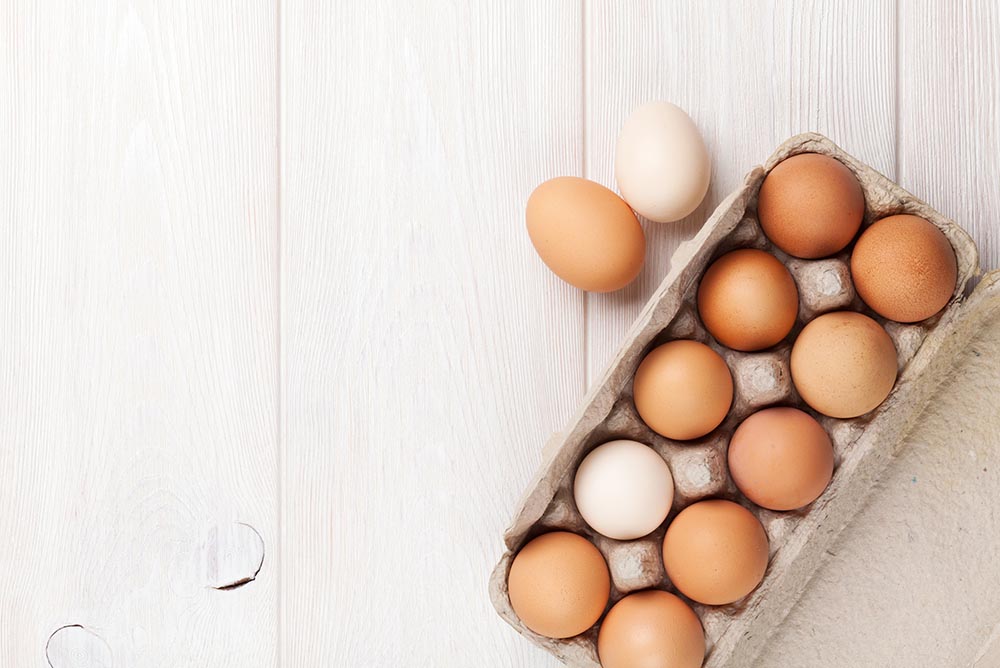
Choose your location
Select the branch you want to collect your order from.
collect From Hazmieh Branch
Brown Eggs Vs. White Eggs

Maybe you've heard that brown rice is more nutritious than white rice. Whole wheat pasta is a little healthier than white pasta. Brown sugar has less chemicals and processing than white sugar. But what about brown eggs versus white eggs?
Most kitchens aren't complete without a dozen eggs, whether you store them in your refrigerator or in a bowl on the counter. Eggs are the heart of many filling breakfasts and an important part of the traditional baking process for cakes and some breads. But all eggs aren't the same. At the store, you'll have plenty of cartons from which to choose. You know what they say: You have to crack a few eggs to make an omelet. So, let's figure out which ones you should use.
Eggs 101
Because eggs are such a regular part of most diets, there's been a lot of debate and research regarding them. Back in the 1960s, nutritionists declared eggs to be too high in cholesterol and a hazard to heart health. But today, hens are fed a different formula that has greatly reduced the amount of cholesterol. A medium-sized egg has about a third of the daily recommended allowance, or about 100 milligrams.
Many health experts preach the importance of eggs in a healthy diet. Eggs are rich in B vitamins, phosphorus, selenium, folate, and Vitamin A. They're packed with vitamins D, E, and K, as well as zinc, calcium, and choline. Plus, one egg contains six grams of protein, making a hard-boiled egg a filling and muscle-building snack. Some vegetarians, who follow a lacto-ovo diet, consider eggs an important source of protein and nutrition.
Breaking Egg Color Myths
While brown foods usually are healthier than the white version, that's not really the case with eggs. In fact, the only difference between a white and brown egg is the breed of hen that laid it. Hens with white features and white earlobes lay white eggs. Hens with red or brown feathers with red earlobes lay brown eggs. Everything else about the eggs are exactly the same–except, perhaps, the price tag. Because there are more white hens, there aren't as many brown eggs. Plus, some people still believe there is a difference and are willing to pay a little extra for brown ones.
Of course, if those brown eggs are produced in an organic farm, they will likely be a higher quality egg. Farmers who have small farms are usually more likely to raise heirloom breeds, so that will explain the higher price tag, as well.
Other Egg-cellent Choices
Besides the color, you'll have to make many other choices to make when purchasing a dozen of eggs. Because these options can make the price vary dramatically–even doubling the cost–you'll want to know what to look for. Organic eggs are some of the healthiest, because the hens who lay these eggs are fed a diet that is free from fertilizers, herbicides, and other chemicals. These hens also usually aren't given unnecessary antibiotics, but you'll want to check the label if this is important to you. Some farmers will feed their hens foods that are high in Omega-3 fatty acids, such as flaxseeds. As a result, the eggs will have more of these "good fats," too.
Hens that live a more relaxed life also tend to produce higher quality, tastier eggs. If this is something you're willing to spend a little extra for, look for a cage-free farm. This means that the hen does not live in a cage but can roam freely in a specific area. Meanwhile, pasture-raised hens are even less stressed. They have an even larger area to roam, and they are able to forage for a wider variety of foods that other hens might not receive through a daily feeding. This complex diet results in a more nutritious (and more expensive) egg for you.
Recipes with Eggs
Of course, eggs stand well on their own when fried over easy, scrambled, hard-boiled, soft-boiled, or poached. But there are plenty of recipes that put an added spotlight on the humble egg. Quiches and omelets are excellent additions to brunch that can feature meat or thyme-scented sautéed mushrooms. Cheese soufflés and crème brulee are fancy and impressive for special occasions. Egg salad is a classic sandwich filling for a picnic, while huevos rancheros or shakshuka can offer unforgettable, ethnic options for egg-lovers.
Of course, egg custards, chocolate tortes, and gelatos are exciting ways to end a meal and satisfy a sweet tooth. When baking, you can cut some calories by leaving out the yolks–depending on the recipe, of course. You can even whip up some magic with egg white-based meringue. Whatever color eggs you decide to use, be creative and have fun.
